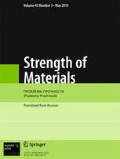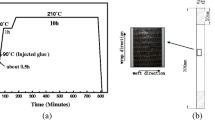An experimental study and numerical calculation are conducted to investigate the crack propagation in a 2D woven composite. Crack propagation tests of single-layer composite plate specimens permit this process to be directly followed. Analysis of their fracture surfaces reveals crack propagation paths, fracture mode, and damage mechanisms. The load–deflection curve represents the crack propagation as a three-stage process. The stress intensity near the crack tip is evaluated with the critical stress intensity factor numerically calculated. The results demonstrate a good agreement between the calculations and experiment.











Similar content being viewed by others
References
N. Liu, X. F. Yao, J. D. Chen, et al., “Research on the impact damage and fracture behavior of braided composites,” J. Exp. Mech., 217, No. 2, 184–190 (2002).
N. Blanco, D. Trias, S. T. Pinho, and P. Robinson, “Intralaminar fracture toughness characterisation of woven composite laminates. Part II: Experimental characterisation,” Eng. Fract. Mech., 131, 361–370 (2014).
T. K. Jacobsen and B. F. Sørensen, “Mode I intra-laminar crack growth in composites – modelling of R-curves from measured bridging laws,” Compos. Part A-Appl. S., 32, No. 1, 1–11 (2001).
M. W. Czabaj and J. G. Ratcliffe, “Comparison of intralaminar and interlaminar mode-I fracture toughness of unidirectional IM7/8552 graphite/epoxy composite,” in: 15th US-Japan Conference on Composite Material, NF1676Ll-15094 (2012).
A. Arguelles, J. Vina, A. F. Canteli, et al., “Interlaminar crack initiation and growth rate in a carbon-fibre epoxy composite under mode-I fatigue loading,” Compos. Sci. Technol., 68, No. 12, 2325–2331 (2008).
M. V. Donadon, B. G. Falzon, L. Iannucci, and J. M. Hodgkinson, “Intralaminar toughness characterisation of unbalanced hybrid plain weave laminates,” Compos. Part A-Appl. S., 38, No. 6, 1597–1611 (2007).
N. Blanco, D. Trias, S. T. Pinho and P. Robinson, “Intralaminar fracture toughness characterisation of woven composite laminates. Part I: Design and analysis of a compact tension (CT) specimen,” Eng. Fract. Mech., 131, 349–360 (2014).
A. Nasirmanesh and S. Mohammadi, “XFEM buckling analysis of cracked composite plates,” Compos. Struct., 131, 333–343 (2015).
S. Mohammadi, XFEM Fracture Analysis of Composites, John Wiley & Sons, Hoboken, NJ (2012).
A. Asadpoure and S. Mohammadi, “Developing new enrichment functions for crack simulation in orthotropic media by the extended finite element method,” Int. J. Numer. Meth. Eng., 69, No. 10, 2150–2172 (2010).
T. Belytschko and T. Black, “Elastic crack growth in finite elements with minimal remeshing,” Int. J. Fract. Mech., 45, No. 5, 601–620 (1999).
A. Asadpoure, S. Mohammadi, and A. Vafai, “Crack analysis in orthotropic media using the extended finite element method,” Thin Wall. Struct., 44, No. 9, 1031–1038 (2006).
A. Asadpoure, S. Mohammadi, and A. Vafai, “Modeling crack in orthotropic media using a coupled finite element and partition of unity methods,” Finite Elem. Anal. Des., 42, No. 13, 1165–1175 (2006).
C. Carloni and L. Nobile, “Crack initiation behaviour of orthotropic solids as predicted by the strain energy density theory,” Theor. Appl. Fract. Mec., 38, No. 2, 109–119 (2002).
C. Carloni, A. Piva, and E. Viola, “An alternative complex variable formulation for an inclined crack in an orthotropic medium,” Eng. Fract. Mech., 70, No. 15, 2033–2058 (2003).
A. Piva and E. Viola, “Crack propagation in an orthotropic medium,” Eng. Fract. Mech., 29, No. 5, 535–548 (1988).
W. Y. Zhang, A Numerical Model of Woven Fabric Composite, Tsinghua University, Beijing (2002).
R. Seifi and N. Khoda-yari, “Experimental and numerical studies on buckling of cracked thin-plates under full and partial compression edge loading,” Thin Wall. Struct., 49, No. 12, 1504–1516 (2011).
H. Tada, P. C. Paris, and G. R. Irwin, The Stress Analysis of Cracks Handbook, ASME Press, New York (2000).
T. L. Anderson, Fracture Mechanics Fundamentals and Applications, CRC Press, Boca Raton (1991).
Acknowledgments
This work was supported by the National Natural Science Foundation of China (Grant No. 51605076, Grant No. 51375068, and Grant No. 51475073), the National Key Basic Research Program of China (Grant No. 2014CB046504), and the Liaoning Province Natural Science Foundation of China (Grant No. 201602171).
Author information
Authors and Affiliations
Corresponding author
Additional information
Translated from Problemy Prochnosti, No. 5, pp. 127 – 134, September – October, 2018.
Rights and permissions
About this article
Cite this article
Wang, Y.Q., Cheng, P., Liu, X.S. et al. Study on a Cracked Single-Layer 2D Woven Composite Plate: Fracture Mode and Damage Analysis. Strength Mater 50, 800–806 (2018). https://doi.org/10.1007/s11223-018-0025-3
Received:
Published:
Issue Date:
DOI: https://doi.org/10.1007/s11223-018-0025-3




